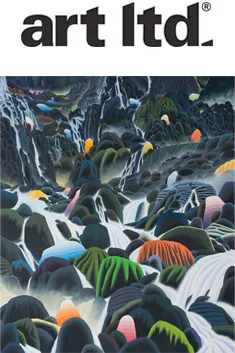
Although titled “New Westerns,” Adam Sorensen’s suite of oil paintings owe more than a little to the Eastern hemisphere. Its vistas of fjords and waterfalls evoke the dramatic terrain of New Zealand, its craggy mountains the Karst hills of Guilin, China. Notably, the artist seems to view landscape as an opportunity to composite eastern conceits with the erstwhile virginal expansiveness of the Great American West. One might imagine these vistas inhabited variously by samurai, cowboys, or perhaps the trolls and fairies of Norse mythology, but such would be only conjecture; there is nary a person nor animal in sight, giving the majestic peaks and ravines a simultaneously lonely and inviting presence. The wild, high-contrast colors impart a quality of reverie and phantasmagoria. In fact, the imagery is more dreamscape than landscape. The painting that perhaps most aptly embodies this ethereality is Flusskeller, which, at 78 x 67 inches, is the largest piece in the show. It depicts a range of fantastically dramatic mountains, waterfalls cascading down, mists rising up, the scene dotted with boulder fields in uncanny hues of blue, orange, and green. Sorensen’s imagery is not realistic, but rather, graphic in a way that recalls Japanese anime. Other works play variations on the theme of craggy pastoral, such as Garrison, with its diabolically glowing red mountains, and Dragon’s Mouth, whose blue rock formations resemble a panoply of oversized Fabergé eggs.
To impart a sense of texture, Sorensen layers slices of heavy impasto one atop the other, simulating the layering of strata in mountain topography. The show’s largest-scale works communicate their romanticized imagery with opulence and élan, while smaller works such as Small Falls 1, 2, and 3 (all 14 x 16 inches), lack the larger works’ panoramic impact. Likewise, the three works in Sorensen’s River Among Snowy Mountains series, which show cascading water silhouetted against a white background, aspire to minimalist elegance but fall short. In these works and the Contrast Falls series, the strategy of relying on black and white does not fully distill the kernel of Sorensen’s strong suit, which is the province of saturated color and preternatural lushness of subject matter. The larger works exude an effectively paradoxical duality of luxuriance and chastity. This land is a paradise, to be sure, but it is a paradise of no one, for no one. Therein lies the imperious, ascetic beauty of Sorensen’s landscapes.
- Richard Speer